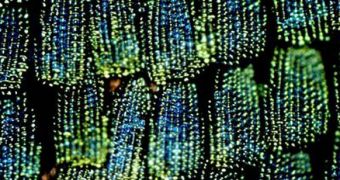One of the things everybody loves about butterflies is the beautiful color their wings have. But these hues are not just aesthetically-pleasing, they also serve additional purposes. The pigments themselves are not plain colors, but reflect light at specific wavelengths and patterns, which makes them all the more interesting. Researchers at the University of Cambridge announce that they were able to replicate these colors, in a work that could have significant implications for the security printing industry.
Over the years, experts have tried to imprint bank notes and credit cards with numerous and varied safety features, meant to prevent fraud and illegal replication. These new colors could be exactly what this industry needs in order to make the ultimate money. Tropical butterflies are apparently key to this, as the Cambridge team can attest. The iridescent colors they replicated can be seen all around in nature, on beetles, butterflies and other insects, but they cannot be readily replicated. Optical physicists and biologists have been collaborating in the research meant to crack the mystery behind the insects' pigments for many years, but this is the first successful attempt at actually mimicking them synthetically.
“We have unlocked one of nature's secrets and combined this knowledge with state-of-the-art nanofabrication to mimic the intricate optical designs found in nature. Although nature is better at self-assembly than we are, we have the advantage that we can use a wider variety of artificial, custom-made materials to optimize our optical structures,” says Mathias Kolle, a professor at Cambridge. He conducted the work with colleagues professor Ullrich Steiner and professor Jeremy Baumberg. The group conducted its research on the Swallowtail butterfly (Papilio blumei),
The creatures do not produce their specific colors by sporting certain hues on their wings. Rather, the colors are produced when light bounces off from small structures on their wings. These formations look like the interior of an egg carton, and they are able to break apart light in very interesting patterns. “These artificial structures could be used to encrypt information in optical signatures on banknotes or other valuable items to protect them against forgery. We still need to refine our system but in future we could see structures based on butterflies wings shining from a £10 note or even our passports,” Kolle adds.
“The shiny green patches on this tropical butterfly's wing scales are a stunning example of nature's ingenuity in optical design. Seen with the right optical equipment these patches appear bright blue, but with the naked eye they appear green. This could explain why the butterfly has evolved this way of producing color. If its eyes see fellow butterflies as bright blue, while predators only see green patches in a green tropical environment, then it can hide from predators at the same time as remaining visible to members of its own species,” the expert says. The team published its findings in the May 30 issue of the esteemed scientific publication Nature Nanotechnology. The work was funded by the Engineering and Physical Sciences Research Council (EPSRC) and the Cambridge Newton Trust.

 14 DAY TRIAL //
14 DAY TRIAL //